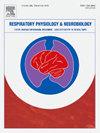小蜥蜴卡罗莱纳蜥蜴的呼吸模式和对环境CO2的通气反应
IF 1.6
4区 医学
Q3 PHYSIOLOGY
引用次数: 0
摘要
蜥蜴和其他爬行动物通常被描述为间歇性呼吸,要么是单次呼吸被不同时期的呼吸暂停分开,要么是长时间的呼吸暂停(即,间歇呼吸)。然而,对小型蜥蜴(≤10 g)的呼吸知之甚少,尽管现存物种的平均体重只有8 g。因此,头-体体积脉搏描记术被用来评估绿蜥(卡洛林斑蜥)的呼吸。在暴露于室内空气(0 % CO2)和高碳化气体混合物(1 %,3 %和5 % CO2)以及高碳化恢复期间,测量成虫(2 - 6 g)的通风量。卡罗林娜在室内空气中表现出连续的、有节奏的呼吸模式,大多数(90% %)呼吸没有任何明显的吸气末暂停;呼吸暂停不常见(1.3 ± 0.2次呼吸暂停/ 5 min(平均值±SEM; n = 16))。在暴露于1 %和5 % CO2时,微小通气量增加主要是由于潮气量的增加,但在3 %和5 % CO2暴露期间,由于每个呼吸周期出现吸气末暂停(以及伴随的呼吸频率减慢),对3 % CO2的响应是可变的。在返回0 % CO2时观察到明显的高碳后呼吸急促,其程度随着高碳挑战的严重程度而增加。尽管对二氧化碳和高碳后呼吸急促的通气反应与其他爬行动物物种的报道一致,但这些数据强调,爬行动物间歇性呼吸的经典描述可能并不适用于所有小蜥蜴,这可能是由于它们更高的质量特异性代谢需求。本文章由计算机程序翻译,如有差异,请以英文原文为准。
Eupneic respiratory pattern and ventilatory responses to environmental CO2 in a small lizard, Anolis carolinensis
Lizards and other reptiles are generally described as breathing intermittently, either with single breaths separated by variable periods of apnea or with clusters of breaths separated by prolonged apneas (i.e., episodic breathing). However, relatively little is known about the breathing of small lizards (≤ 10 g) even though the average body mass of extant species is only 8 g. Accordingly, head-body plethysmography was used to assess breathing in the green anole (Anolis carolinensis). Ventilation was measured in adult anoles (2 – 6 g) while exposed to room air (0 % CO2) and hypercarbic gas mixtures (1 %, 3 %, and 5 % CO2), and during recovery from hypercarbia. A. carolinensis exhibited a continuous, rhythmic breathing pattern in room air with most (90 %) breaths lacking any discernible end-inspiratory pause; apneas were infrequent (1.3 ± 0.2 apneas per 5 min (mean±SEM; n = 16)). Minute ventilation increased during exposures to 1 % and 5 % CO2 largely through increases in tidal volume, but the response to 3 % CO2 was variable due to the emergence of end-inspiratory pauses each respiratory cycle (and concomitant slowing of respiratory frequency) during the 3 % and 5 % CO2 exposures. A marked post-hypercarbic hyperpnea was observed during the return to 0 % CO2, the magnitude of which increased with the severity of the hypercarbic challenge. Although the ventilatory responses to CO2 and post-hypercarbic hyperpnea are consistent with reports for other reptile species, these data highlight that the classic description of intermittent breathing in reptiles may not apply to all small lizards, perhaps due to their higher mass-specific metabolic demands.
求助全文
通过发布文献求助,成功后即可免费获取论文全文。
去求助
来源期刊
CiteScore
4.80
自引率
8.70%
发文量
104
审稿时长
54 days
期刊介绍:
Respiratory Physiology & Neurobiology (RESPNB) publishes original articles and invited reviews concerning physiology and pathophysiology of respiration in its broadest sense.
Although a special focus is on topics in neurobiology, high quality papers in respiratory molecular and cellular biology are also welcome, as are high-quality papers in traditional areas, such as:
-Mechanics of breathing-
Gas exchange and acid-base balance-
Respiration at rest and exercise-
Respiration in unusual conditions, like high or low pressure or changes of temperature, low ambient oxygen-
Embryonic and adult respiration-
Comparative respiratory physiology.
Papers on clinical aspects, original methods, as well as theoretical papers are also considered as long as they foster the understanding of respiratory physiology and pathophysiology.

 求助内容:
求助内容: 应助结果提醒方式:
应助结果提醒方式:


